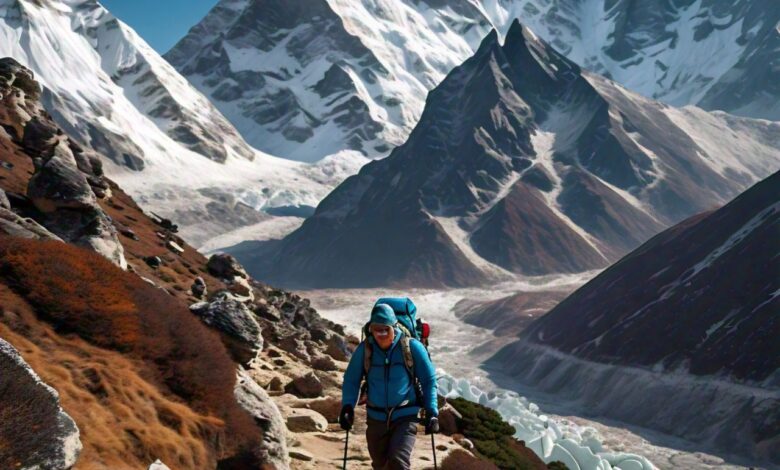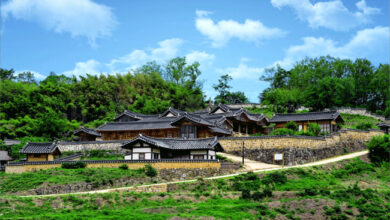Everest Base Camp Trek A Budget Traveler’s Guide

The Everest Base Camp trek, one of the most renowned hiking adventures in the world, offers a thrilling experience for those seeking to witness the grandeur of the Himalayas without necessarily breaking the bank. For budget travelers, navigating this iconic journey requires careful planning and savvy decision-making to balance cost and experience.
Starting with the essentials, one of the most significant expenses on the trek is the flight from Kathmandu to Lukla, the gateway to the Everest region. This flight is notoriously expensive, but booking in advance and being flexible with travel dates can yield more affordable options. Alternatively, some trekkers choose to undertake the overland journey from Kathmandu to Jiri and then start their trek, though this adds several extra days of trekking and is a more arduous option.
Accommodation along the trek is relatively budget-friendly, thanks to the numerous teahouses that line the route. These teahouses offer basic lodging and meals at reasonable prices, making them a suitable choice for cost-conscious trekkers. Staying in these teahouses not only provides an authentic local experience but also helps to reduce costs. It is advisable to carry a sleeping bag, as some teahouses might not provide adequate bedding or warmth.
Food costs can also be managed by opting for local dishes rather than Western fare. While the teahouses offer a range of menu items, sticking to traditional Nepali dishes like dal bhat, a hearty meal of rice, lentils, and vegetables, can be more economical. Additionally, many trekkers find that purchasing snacks and additional supplies in Kathmandu before setting out can help avoid higher prices in the more remote areas of the trek.
Permits and park fees are necessary expenses that all trekkers must account for. The TIMS (Trekkers’ Information Management System) card and Sagarmatha National Park entry permit are required, and while these fees are unavoidable, they are relatively modest compared to the overall cost of the trek. Ensuring that all necessary paperwork is handled before departure can prevent unexpected hassles and additional costs.
Travel insurance is a crucial yet often overlooked aspect of trekking. While it might seem like an additional expense, insurance covering high-altitude trekking is vital for safeguarding against potential emergencies, such as altitude sickness or injury. Choosing a policy that includes evacuation coverage ensures that any unforeseen medical issues can be addressed without incurring exorbitant costs.
Finally, while the Everest Base Camp trek can be completed on a budget, the experience of this trek goes beyond mere expenses. The breathtaking landscapes, the challenge of the high-altitude journey, and the opportunity to engage with the local Sherpa culture offer priceless rewards. With thoughtful planning and a bit of flexibility, budget travelers can enjoy this once-in-a-lifetime adventure without compromising on the quality of their experience.
Introduction to the Everest Base Camp Trek
The Short Everest Base Camp trek is a premier adventure that draws trekkers from around the globe to the foot of the world’s highest peak. Located in the Khumbu region of Nepal, this trek offers an unparalleled opportunity to experience the majestic Himalayas and immerse oneself in the unique Sherpa culture. The journey to Base Camp, situated at 5,364 meters (17,598 feet) above sea level, typically spans about 12 to 14 days, covering a distance of approximately 130 kilometers (80 miles) round-trip. Trekkers traverse diverse landscapes, from lush valleys and dense forests to rugged, high-altitude terrain, all while enjoying breathtaking views of towering peaks like Lhotse and Nuptse. Along the way, the trek passes through traditional Sherpa villages, ancient monasteries, and picturesque landscapes, providing a rich cultural and scenic experience. The trek is challenging due to the high altitude and varying weather conditions, but it remains accessible to those with reasonable fitness and determination. The reward of reaching Everest Base Camp and witnessing the towering grandeur of Mount Everest is a profound and memorable experience, making the trek a bucket-list adventure for many.
Planning Your Trip: Essential Considerations
Planning for the Everest Base Camp trek involves several essential considerations to ensure a successful and enjoyable journey. First and foremost, it is crucial to assess your physical fitness and prepare accordingly, as the trek requires endurance and the ability to handle high altitudes. It is advisable to engage in cardiovascular and strength training in the months leading up to the trek. Additionally, obtaining the necessary permits, including the TIMS (Trekkers’ Information Management System) card and the Sagarmatha National Park entry permit, is essential. Booking flights and accommodations in advance can help streamline the process, especially during peak trekking seasons. Selecting a reputable trekking agency, if opting for a guided trek, can enhance the experience by providing support, local expertise, and safety measures. It is also wise to prepare for varying weather conditions by packing appropriate gear, such as insulated clothing, waterproof layers, and trekking poles. Finally, acclimatization is crucial; allowing time for proper acclimatization during the trek helps prevent altitude sickness and ensures a safer journey.
Choosing the Best Time to Visit
Choosing the best time to visit Everest Base Camp is crucial for optimizing your trekking experience. The peak trekking seasons are typically pre-monsoon (April to early June) and post-monsoon (late September to November). During these periods, the weather is relatively stable, with clearer skies and lower chances of heavy snowfall, making for better trekking conditions. Pre-monsoon season offers warmer temperatures and longer daylight hours, though it can be busier with more trekkers. Post-monsoon, the weather is cooler, but the trails are less crowded, providing a more serene experience. Both seasons offer stunning views of the Himalayas and are generally considered the best times for trekking. The monsoon season (June to August) brings heavy rains and increased risk of landslides, while the winter months (December to February) are characterized by extreme cold and snow, making trekking conditions more challenging and less predictable. Choosing the right time depends on your preferences for weather, crowd levels, and trekking conditions.
Budget Breakdown: Costs and Expenses
Understanding the budget for the Everest Base Camp trek is crucial for planning a successful trip without financial surprises. The major expenses include permits, flights, accommodation, and food. The TIMS card and Sagarmatha National Park entry permit collectively cost around $50 to $100. Flights from Kathmandu to Lukla, the gateway to the Everest region, are one of the largest expenses, typically ranging from $200 to $300 for a round-trip. Accommodations along the trek are relatively affordable, with teahouses charging between $10 to $30 per night, depending on the altitude and location. Meals are additional and usually cost around $10 to $20 per day. Trekkers should also budget for personal expenses, such as gear rental, tips for guides and porters, and any unforeseen costs. A comprehensive budget plan should account for these elements, ensuring that all aspects of the trek are covered. In total, a budget traveler might expect to spend around $1,500 to $2,500 for the entire trek, including all essential expenses and a modest buffer for contingencies.
Transportation: Getting to and from Nepal
Transportation to and from Nepal is a crucial aspect of planning for the Everest Base Camp trek. Most trekkers arrive in Nepal via Tribhuvan International Airport in Kathmandu, the country’s main international gateway. Direct flights are available from major cities in Asia, Europe, and North America, though travelers may need to transit through other hubs. Upon arrival in Kathmandu, travelers typically spend a few days in the city to finalize permits, arrange logistics, and prepare for the trek. From Kathmandu, the journey to the Everest region involves a flight to Lukla, the primary starting point for the trek. The Lukla flight is a short, scenic trip but can be subject to weather-related delays. For those seeking alternatives, overland travel to Jiri followed by a trek to Lukla is possible, though this option adds extra days to the journey. After completing the trek, trekkers return to Kathmandu via the Lukla flight, concluding their adventure and preparing for departure.
Permits and Fees: What You Need to Know
When embarking on the Everest Base Camp trek, securing the necessary permits and understanding associated fees are crucial steps in the planning process. Two primary permits are required: the TIMS (Trekkers’ Information Management System) card and the Sagarmatha National Park entry permit. The TIMS card costs approximately $10 to $20 and is essential for tracking and managing trekkers’ information. The Sagarmatha National Park entry permit is priced around $30 to $50, depending on the nationality of the traveler. Both permits can be obtained in Kathmandu before the trek, with most trekking agencies assisting in the process. The fees contribute to the maintenance of the trekking infrastructure and the protection of the natural environment. It’s important to budget for these permits as part of the overall trekking expenses. Additionally, some agencies may include permit fees in their packages, so it’s wise to confirm this when booking through a tour operator. Being well-prepared with the correct permits ensures a smoother trek and adherence to local regulations.
Accommodation Options: From Teahouses to Budget Stays
Accommodation along the Everest Base Camp trek ranges from basic teahouses to more budget-friendly options, catering to a variety of preferences and needs. Teahouses are the most common lodging choice and provide a simple, yet comfortable place to rest. They offer basic rooms with shared facilities, typically costing between $10 to $30 per night, depending on the altitude and location. In higher altitudes, where accommodation options are more limited, prices tend to be higher. For those on a strict budget, staying in teahouses and avoiding pricier lodges can help keep costs down. It is advisable to book accommodations in advance during peak trekking seasons to secure a place and avoid last-minute hassles. Additionally, some trekkers opt for guesthouses or lodges with slightly more amenities, which can be found along the route. Regardless of the choice, staying in teahouses not only offers a practical solution but also allows for cultural immersion and interaction with local communities.
Food and Dining: Affordable Eating Along the Trail
Food and dining on the Everest Base Camp trek map can be managed affordably by choosing local dishes and understanding the pricing structure. Teahouses along the trail offer a variety of meals, with local Nepali dishes such as dal bhat (rice and lentils), momos (dumplings), and noodle soups being more budget-friendly compared to Western-style meals. The cost of food typically ranges from $10 to $20 per day, depending on the menu choices and the altitude of the teahouse. To save money, it is advisable to stick to local cuisine and avoid ordering expensive imported items. Many teahouses also offer meal packages, which can be a cost-effective option for trekkers. Additionally, purchasing snacks and energy bars in Kathmandu before starting the trek can help manage costs and ensure you have sufficient provisions. By opting for affordable, locally-prepared meals and minimizing high-cost items, trekkers can maintain a budget-friendly dining experience while enjoying the local flavors of the region.
Gear and Equipment: What to Bring on a Budget
Packing the right gear for the Everest Base Camp trek is essential for comfort and safety, especially when traveling on a budget. Essential items include a durable pair of trekking boots, which provide support and grip on uneven terrain, and a well-fitting backpack to carry personal belongings. A good-quality sleeping bag suitable for high altitudes is necessary, and while some teahouses provide bedding, a personal sleeping bag ensures warmth and comfort. Trekking poles can also be beneficial for stability and reducing strain on steep sections. For budget travelers, purchasing or renting gear in Kathmandu can be a cost-effective option, as local shops offer competitive prices and a range of equipment. Investing in key items like a windproof and waterproof jacket, thermal layers, and a hat and gloves is important for managing varying weather conditions. By prioritizing essential gear and considering local rental options, trekkers can manage their budget while ensuring they are adequately equipped for the trek.
Tips for Saving Money on the Trek
Saving money on the Everest Base Camp trek involves a combination of strategic planning and cost-effective choices. One of the primary ways to save is by opting for budget-friendly teahouses for accommodation and eating locally prepared meals instead of international cuisine. Booking flights and permits in advance can also help avoid higher costs associated with last-minute arrangements. Additionally, carrying some snacks and personal supplies from Kathmandu can reduce the need to purchase expensive items along the trail. Trekking independently rather than through an organized tour can further lower expenses, though this requires careful planning and navigation skills. To save on gear costs, consider renting equipment locally rather than buying new items. Lastly, traveling during the shoulder seasons, such as early spring or late autumn, can help avoid peak season prices and crowded trails. By making thoughtful choices and preparing in advance, trekkers can enjoy the Everest Base Camp experience while keeping costs under control.
Health and Safety: Staying Safe on a Budget
Ensuring health and safety on the Everest Base Camp trek Itinerary is paramount, particularly for budget travelers who need to manage both their well-being and expenses. One of the primary health concerns is altitude sickness, which can affect anyone trekking at high elevations. To mitigate this risk, it’s essential to acclimatize properly by ascending gradually and allowing rest days to adjust to the thinning air. Staying hydrated, eating nutritious food, and avoiding alcohol can further help in acclimatization and overall health. Carrying a basic first-aid kit, including medications for common issues like headaches, gastrointestinal problems, and cold symptoms, is also advisable. While budget travelers may not afford expensive evacuation insurance, securing a basic travel insurance policy that covers emergency medical evacuation is crucial. In terms of safety, adhering to local guidelines and respecting weather conditions is important. For cost-saving measures, consider traveling with a group or joining a budget trekking package that includes safety measures and medical support. Ensuring personal safety by following the trek’s recommended routes and avoiding risky shortcuts can also prevent accidents and injuries.
Navigating the Trek: Routes and Navigation Tips
Navigating the Everest Base Camp trek involves following established routes while being prepared for the rugged terrain. The primary route from Lukla to Everest Base Camp is well-marked, and most trekkers use this path, which passes through notable landmarks such as Namche Bazaar, Tengboche, and Dingboche. While the path is relatively straightforward, having a detailed map or a GPS device can enhance navigation and provide reassurance. For budget travelers, hiring a local guide is an option to consider, though it is an additional expense. Guides can offer valuable insights, ensure safe navigation, and assist with cultural interactions. However, if traveling independently, ensuring you have a reliable map, a compass, or a GPS application on your smartphone can be sufficient for navigating the trek. Additionally, familiarizing yourself with key landmarks and the route profile beforehand can help in planning daily trekking distances and timings. Understanding the layout of the trek and maintaining awareness of your surroundings are crucial for a safe and successful journey.
Cultural Etiquette and Interaction with Locals
Respecting cultural etiquette and interacting thoughtfully with locals enhances the Everest Base Camp trek experience and fosters positive relationships with the Sherpa community. When visiting villages and monasteries, dress modestly and remove your hat or sunglasses when entering religious sites. It is polite to ask permission before taking photographs, especially of people. The Sherpa people are known for their hospitality, so responding with friendliness and respect is appreciated. Engaging in basic Nepali greetings and phrases can also show respect and create rapport. Additionally, tipping guides and porters is customary and appreciated, even if on a budget. Showing gratitude through small gestures and supporting local businesses, such as purchasing souvenirs or local crafts, helps sustain the community economically. Being mindful of local customs, such as removing your shoes before entering homes or teahouses, and adhering to traditional practices fosters mutual respect and enriches the trekking experience.
Managing Altitude Sickness and Health Concerns
Managing altitude sickness is crucial for a safe and enjoyable Everest Base Camp trekking, especially on a budget. Symptoms of altitude sickness include headaches, nausea, and dizziness, which can occur as trekkers ascend to higher elevations. To reduce the risk, it is essential to follow the principle of gradual ascent, allowing your body time to acclimate. Aim to increase altitude slowly, and incorporate rest days into your itinerary to aid acclimatization. Staying hydrated and eating a balanced diet also supports your body’s adjustment to high altitudes. Carrying medications such as acetazolamide (Diamox) can help prevent altitude sickness, and it’s wise to consult with a healthcare provider before the trek to ensure you have the appropriate medications. If symptoms persist or worsen, descending to a lower altitude is crucial. Having a plan for emergency evacuation, even if on a tight budget, is important for addressing severe health issues promptly. Being proactive about health and altitude management ensures a safer trek experience.
Post-Trek: Budget-Friendly Activities in Nepal
After completing the Everest Base Camp trek, there are several budget-friendly activities to enjoy in Nepal, allowing travelers to make the most of their visit without overspending. In Kathmandu, explore the vibrant Thamel district, where you can find affordable dining, shopping, and cultural experiences. Visit historic sites such as Swayambhunath (the Monkey Temple) and Boudhanath Stupa, which offer rich cultural insights and can be explored on a modest budget. Additionally, consider visiting Pokhara, a picturesque city known for its serene lakes and adventure sports. Budget accommodations and affordable eateries are plentiful in Pokhara, making it a great spot to relax and enjoy activities like boating on Phewa Lake or exploring nearby waterfalls and caves. For those interested in further trekking, the Annapurna region offers shorter, less expensive treks that provide stunning mountain views. By exploring these affordable options, travelers can enrich their Nepal experience while adhering to a budget.


